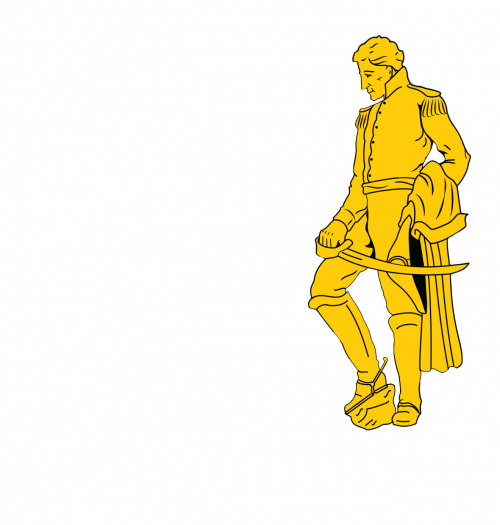Fort Jackson is the largest and most active Initial Entry Training center in the U.S. Army, training 50% of all Soldiers entering the Army each year. Providing the Army with new Soldiers is the post's primary mission. Roughly 35,000 potential Soldiers attend Basic Combat Training and 8,000 Advanced Individual Training Soldiers train at Fort Jackson annually. The training is provided by the 165th and 193rd Infantry Brigades, Monday through Sunday, for a 10-week period.
While some military installations have experienced downsizing and closure in past years, Fort Jackson has added several new schools and training institutions since 1995, including the U.S. Army Soldier Support Institute, the U.S. Army Institute for Religious Leadership, and the National Center for Credibility Assessment, part of the Defense Intelligence Agency. In 2007, the Army consolidated all its training facilities for drill sergeants at Fort Jackson.
Fort Jackson encompasses approximately 51,316 acres of land, including 100 ranges and field training sites and more than 1,000 buildings. Soldiers, civilians, retirees, and family members make up the Fort Jackson community that continues to grow in numbers and facilities. An additional 10,000 Soldiers attend courses at U.S. Army Soldier Support Institute, the U.S. Army Institute for Religious Leadership, and the U.S. Army Drill Sergeant Academy annually. An estimated 3,500 active-duty personnel and their 12,000 military family members make the Fort Jackson area their home with about one-third of that total population residing on-post. Close to 3,500 civilians are employed at Fort Jackson and 46,000-plus retirees and their families receive services from this base.
Overview
Historical Overview
Established in 1917 as Camp Jackson and named in honor of President Andrew Jackson, the installation has played a pivotal role in preparing soldiers for service in every major conflict of the 20th and 21st centuries. The installation’s history reflects broader changes in U.S. military doctrine, infrastructure, and society. The following timeline outlines Fort Jackson’s development and contributions across key war eras, highlighting both military milestones and cultural evolution on post.
World War I era
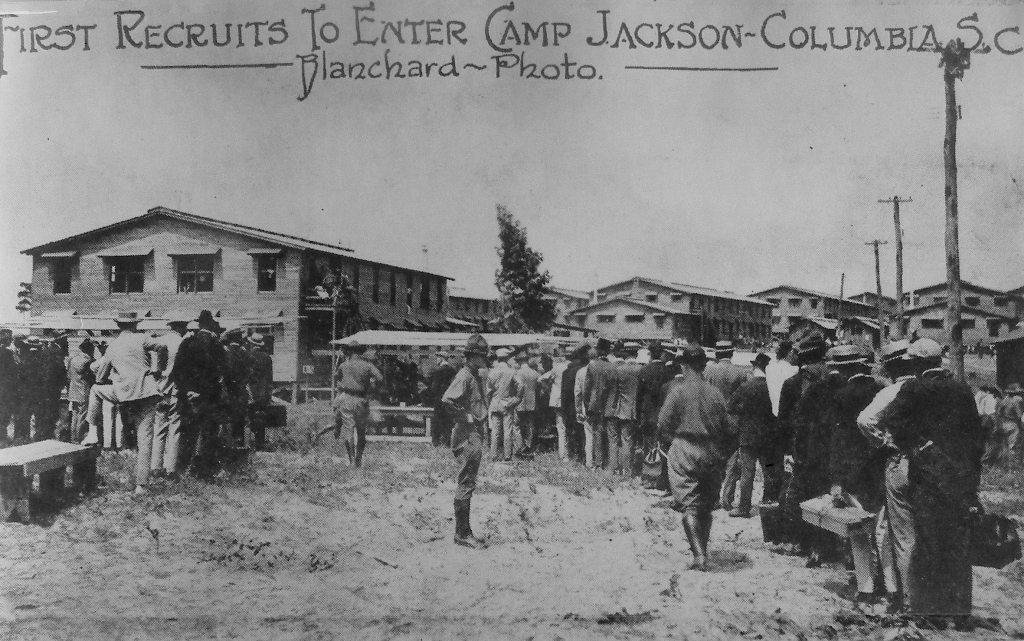 World War I Era (1914-1918)
World War I Era (1914-1918)
The United States declared war on Germany April 7, 1917, and on May 24, 1917, Congress passed War Bulletin Number 32 which authorized the President to increase the American military. On May 19, 1917, Columbia, SC was designated as a site for one of the new Army divisional training camps and by June 2, 1917, the War Department granted final approval for the location of an Army training center in Columbia, SC, and construction began on Camp Jackson.
For the construction of the new Army cantonments, speed was the priority.
In the first phase of construction from June to December 1917, more than 1500 buildings were completed and over the next year another 550 buildings would be added to the camp. Camp Jackson's original building inventory included 119 Officer's quarters, 402 Enlisted barracks, 403 lavatories, 35 additional mess halls, 189 stables, 26 support administrative buildings, 13 post exchanges, 12 guard houses, 51 store houses, 16 shops, 3 garages, 102 sheds, 4 magazines, 7 civic buildings, 3 fire stations, a post office, a laundry building, a bakery, a telephone/telegraph building, a sewage disposal building, and a base hospital with more than 60 buildings. In addition to the buildings, the construction of Camp Jackson included the installation of a water supply and distribution system, a sewage system, an electrical system, telephone/telegraph lines, roads and railroad tracks.
[Excerpts from The Birth of Camp Jackson, published by the U.S. Army Basic Combat Training Museum, 2016]
Interwar period
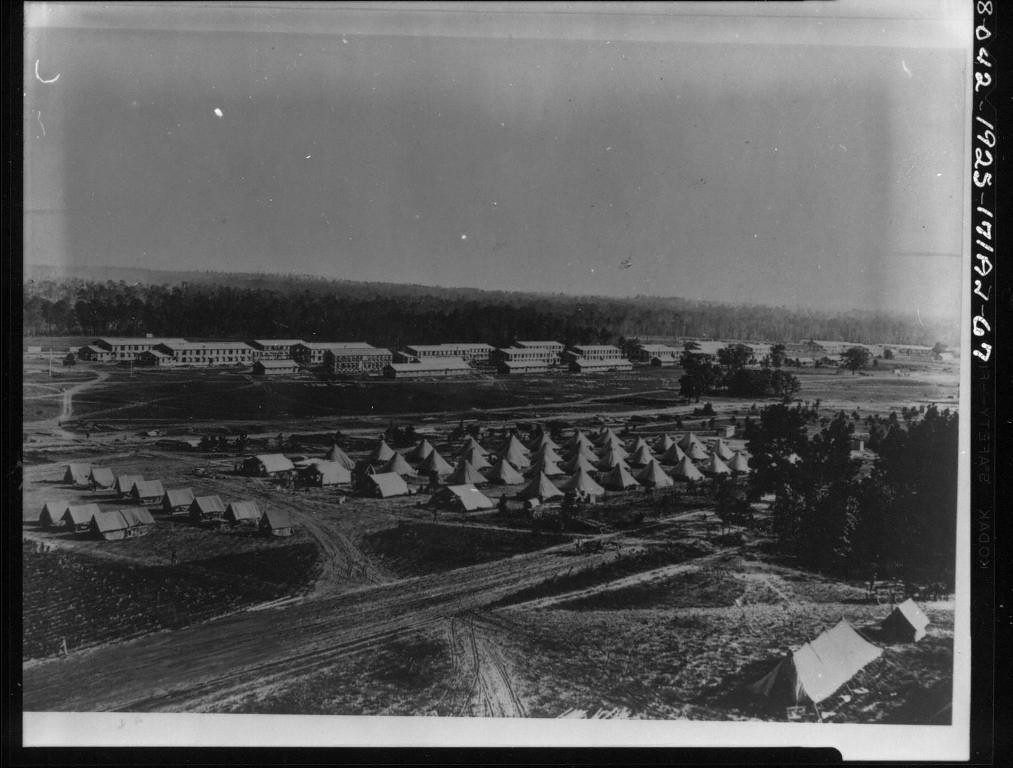 Interwar Period
Interwar Period
At the conclusion of World War I, Camp Jackson was shut down on April 25, 1922-1939. Between 1925 and 1940 it served as an encampment and training area for the S.C. National Guard.
World War II era
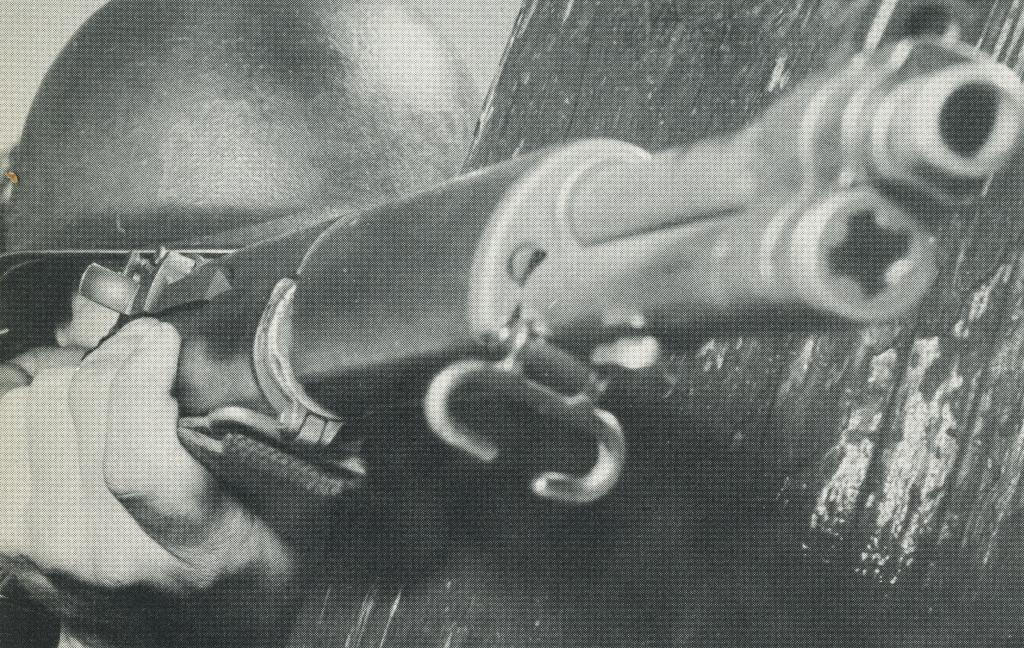 World War II Era (1939-1945)
World War II Era (1939-1945)
With the outbreak of World War II, Fort Jackson (officially changed from Camp Jackson in 1940) was reactivated and rapidly expanded to meet the demands of a growing Army. During U.S. involvement (1941-1945) the installation became a major training center, preparing tens of thousands of soldiers for deployment to both the European and Pacific theaters.
One of Fort Jackson’s most innovative contributions during this period was the development of immersive training environments. Among the earliest and most notable was a mock German Village, constructed to simulate the types of urban environments soldiers would encounter in Europe. This village included a series of buildings arranged to resemble a small European town, complete with narrow streets and varied architecture. Though documentation is limited, internal sources and museum historians suggest Fort Jackson may have been one of the first U.S. Army installations to implement this kind of experiential training.
The German Village was used to familiarize soldiers with the layout and feel of European towns, helping them prepare for urban combat, reconnaissance, and occupation duties. It also served as a setting for instructional demonstrations and possibly early forms of cultural orientation. This approach to training—emphasizing realism and environmental familiarity—would later influence similar efforts during the Vietnam War.
In addition to immersive training, Fort Jackson hosted large-scale unit training exercises and served as a staging ground for several divisions. The post’s infrastructure grew significantly during this time, with the construction of barracks, motor pools, administrative buildings, and support facilities to accommodate the influx of personnel.
Cold War Era
Cold War Era (1947-1991)
During the Cold War, Fort Jackson continued to serve as a critical training and administrative hub for the U.S. Army. The installation adapted to the evolving needs of the military, including the introduction of new training programs and the 1970 construction of additional facilities. Building 1895, the 120th Adjutant General Battalion (Reception), is a notable example of Cold War-era military architecture. Constructed in the mid-20th century, it played a key role in personnel processing and has been determined eligible for listing on the National Register of Historic Places (NRHP) as the work of a master architect.
Korean War Era
Korean War Era (1950-1953)
Following the end of World War II, Fort Jackson was slated for deactivation. However, the outbreak of the Korean War in 1950 reversed that decision, and the installation remained active to support the rapid mobilization of U.S. forces. Fort Jackson once again became a key site for basic and advanced training, preparing thousands of soldiers for deployment to the Korean Peninsula.
During this period, the post expanded its infrastructure and training programs to meet the demands of a new kind of warfare, one that combined conventional combat with rugged terrain and extreme weather conditions. While immersive mock villages like those used in World War II were not as prominent during this era, Fort Jackson continued to innovate in training delivery, emphasizing speed, adaptability, and readiness.
The Korean War also marked a turning point in the integration of the U.S. Army. Fort Jackson played a role in training soldiers from increasingly diverse backgrounds, reflecting the broader desegregation of the armed forces initiated by Executive Order 9981 in 1948.
Vietnam War Era
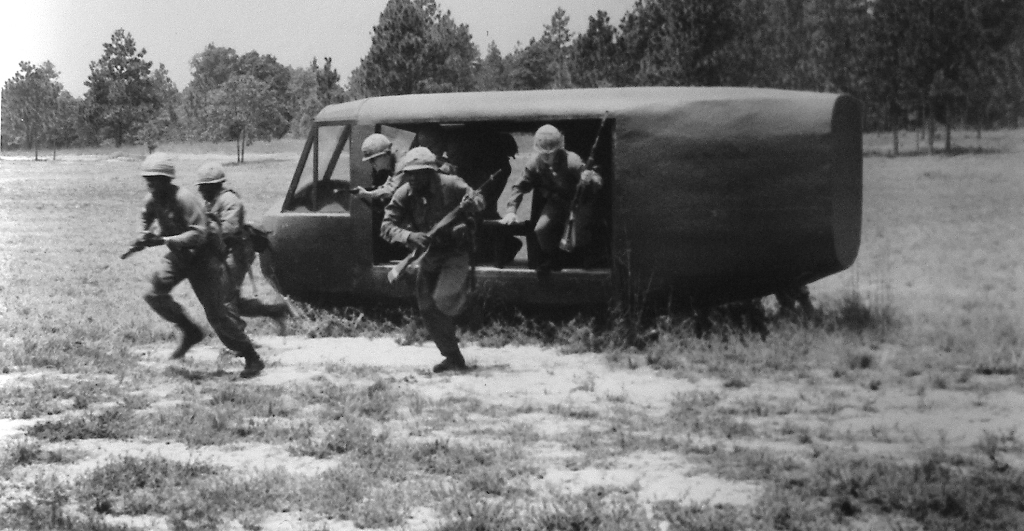 Vietnam War Era (1955-1975)
Vietnam War Era (1955-1975)
During the 1960s, Fort Jackson played a critical role in preparing soldiers for deployment to Southeast Asia. As the U.S. commitment to the Vietnam War intensified, the installation adapted its training programs to reflect the unique challenges of jungle warfare and counterinsurgency operations.
One of the most distinctive training features developed during this period was Bau Bang Village, named after a real location in Vietnam and translated colloquially as “Bad News.” This simulated Vietnamese hamlet was constructed to mirror the types of rural environments soldiers would encounter “in country,” regardless of their specific assignment location. The village included a variety of building types and layouts typical of Vietnamese settlements, providing a realistic backdrop for cultural orientation and situational awareness.
Unlike other mock villages used primarily for tactical field exercises, Bau Bang was designed for exhibition and classroom instruction. It served as a controlled environment where soldiers could learn about local customs, potential threats, and the physical layout of Vietnamese communities. The training was enhanced by using helicopters, which added realism and helped simulate the rapid deployment scenarios common in Vietnam.
Instructional displays within the village included captured enemy weapons, booby traps, and other artifacts, which were used to educate soldiers on the dangers they might face and how to identify and neutralize them. This hands-on, immersive approach to training helped prepare thousands of infantrymen for the complex and often unpredictable conditions of the Vietnam War. Bau Bang was relocated following the impoundment of Weston Lake and two further mock villages constructed in 1967: Vien Hoa and Pien Chu.
In 1973, Fort Jackson was officially designated a U.S. Army Training Center, reflecting its expanding and enduring role in preparing soldiers during and beyond the Vietnam conflict.
Post-Vietnam to Present
Post-Vietnam to Present
Following the Vietnam War, Fort Jackson continued to adapt to the changing needs of the U.S. Army. The post remained a cornerstone of basic combat training, but its mission expanded significantly in the decades that followed. As the nature of warfare and military readiness evolved, so too did the training methods, facilities, and institutional roles at Fort Jackson.
In the 1990s and early 2000s, Fort Jackson became home to several key Army institutions, including the U.S. Army Soldier Support Institute, the Army Chaplain Center and School, and the National Center for Credibility Assessment, which supports the Defense Intelligence Agency. These additions reflected a broader shift toward specialized training and support services, reinforcing Fort Jackson’s role as a comprehensive training hub.
In 2007, the Army consolidated all its drill sergeant training at Fort Jackson, establishing it as the sole location for the U.S. Army Drill Sergeant Academy. This move further cemented the post’s reputation as the heart of soldier transformation. In 2009, Command Sergeant Major Teresa King made history as the first woman to lead the Drill Sergeant School, marking a milestone in Army leadership.
Fort Jackson has also played a role in preparing soldiers for modern conflicts, including Operations Desert Shield and Desert Storm, Operation Iraqi Freedom, and Operation Enduring Freedom. Training has increasingly emphasized adaptability, cultural awareness, and readiness for asymmetric warfare. The use of immersive environments, simulations, and updated field exercises continues to evolve in response to global threats.
Today, Fort Jackson trains approximately 50% of all soldiers entering the Army each year. With over 35,000 basic trainees and 8,000 advanced individual training soldiers annually, the post remains the Army’s largest and most active initial entry training center. It spans more than 51,000 acres, with over 1,000 buildings, 100 ranges, and a growing community of soldiers, civilians, retirees, and families.
Fort Jackson’s enduring mission is not only to train soldiers but to shape the future of the Army, adapting to new challenges while honoring a legacy of service that spans more than a century.
Historical Structures
Historic Structures at Fort Jackson
While Fort Jackson is a modern, mission-focused installation, it is also home to several buildings of historical and architectural significance. These structures reflect the evolution of Army infrastructure and training environments over the past century. Select buildings have been documented through the Historic American Buildings Survey (HABS) as part of ongoing preservation and mitigation efforts.
Building 1895 – 120th Adjutant General Battalion (Reception)
Constructed in the mid-20th century, Building 1895 served as the reception facility for the 120th Adjutant General Battalion. Though utilitarian in design, the structure is significant as a representative example of Cold War-era military architecture and administrative function. It has been determined eligible for listing on the National Register of Historic Places (NRHP) as the work of a master architect and for its role in the Army’s personnel processing mission. HABS documentation is being completed as part of mitigation for planned demolition.
Moncrief Army Health Clinic
Moncrief Clinic is one of Fort Jackson’s most recognizable historic medical facilities. Originally constructed in the early 20th century and expanded over time, the clinic has served generations of soldiers and their families. Its architectural style reflects the transitional period between temporary mobilization structures and more permanent post infrastructure. While no longer the primary medical facility on post, Moncrief remains a landmark of Fort Jackson’s commitment to soldier care.
1930s Motor Pool Garage
This garage, dating to the 1930s, is one of the few remaining examples of Depression-era military construction on Fort Jackson. Built during a time of national economic hardship and military downsizing, the structure reflects the Army’s logistical and vehicular support needs prior to World War II. Its simple, durable design is typical of the era and contributes to the broader understanding of pre-war Army infrastructure.
Anderson Chapel
Anderson Chapel is a modest but historically significant religious structure on Fort Jackson. The chapel has served as a spiritual home for soldiers of many faiths since its construction in 1967. Its enduring presence reflects the Army’s commitment to religious support and the role of chaplains in soldier readiness and morale. The chapel’s modernist architecture, while simple, is emblematic of mid-century military chapels built for function, flexibility, and community.
Fort Jackson Museum Community
Fort Jackson Museum Community
The Fort Jackson Museum Community (FJMC) at Fort Jackson, South Carolina, consists of four museums: the Fort Jackson, U.S. Army Chaplain, U.S. Army Adjutant General Corps, and U.S. Army Finance Corps Museums. More information can be found by visiting this website: https://history.army.mil/Army-Museum-Enterprise/Find-an-Army-Museum/US-Army-Basic-Combat-Training-Museum/





